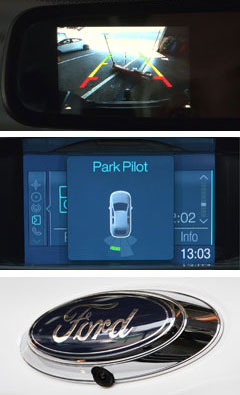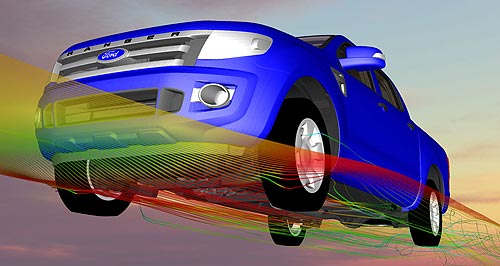Future models - Ford - RangerF1 aero aces shape Aussie uteFormula for success: Former F1 engineers Thorsten Maertens (left) and Neil Lewington show off their aero tweaks on the new Ford Ranger. Ford Aus employs top F1 aerodynamicists to improve new Ranger’s fuel economy21 Mar 2011 TWO engineers with expertise honed in the aero-intense world of formula one racing have turned their hand to the development of a humble ute Down Under. Former F1 aerodynamics engineers Thorsten Maertens and Neil Lewington were brought into the Ranger program to use racing-style simulation software to fine-tune the ute design and enhance fuel efficiency. Both men have extensive F1 experience and were lured to Broadmeadows by Ford Australia four years ago. Mr Maertens was educated in Germany and spent almost six years as a CFD (computational fluid dynamics) engineer at Toyota Motorsport in Cologne before briefly working at Hyundai Motor Europe’s technical centre at Russelsheim. Dr Lewington studied aeronautics in London and joined Ford Australia after almost five years as a senior CFD engineer at McLaren Racing, where he ended up leading a team of seven engineers working on F1 car development. Their expertise underlines the commitment that has been made to development of the locally designed and developed Ranger ute, which is due to hit Australian showrooms in both 4x4 and 4x2 variants in double-cab and single-cab configurations in the third quarter. The Ranger is expected to be powered by a choice of three engines – a 147kW/470Nm 3.2-litre five-cylinder diesel engine transplanted from the Ford Transit, a 2.2-litre 110kW/375Nm four-cylinder diesel and a 122kW/226Nm 2.5-litre version of Ford’s four-cylinder EcoBoost petrol powerplant.  Left: Ford's rear view camera system, which displays within the rear view mirror and is situated in the rear Ford badge. Left: Ford's rear view camera system, which displays within the rear view mirror and is situated in the rear Ford badge.Ford claims the imported aero gurus performed more than 1000 full-vehicle aerodynamic simulations to perfect the shape of Ranger for fuel efficiency, resulting in a deep front air dam and a small spoiler on the lip of the tailgate. Mr Maertens, who supervises the aerodynamics team, said the biggest drag reduction came from the front air dam, which limits the amount of flow that goes under the vehicle and effectively cuts the drag by about seven per cent while improving vehicle stability and helping to cool the engine. “A key challenge was managing the interactions between the air flowing over the roof and the variations of cargo boxes in the Ranger lineup, as this constitutes a significant proportion of the vehicle drag,” said Mr Maertens. “The pickup’s ride height, especially in the 4x4 models, was another challenge. The higher the vehicle, the more aerodynamic drag it has to overcome. It’s a big number for every millimetre of ride height.” Working with the designers, the aerodynamics team also reportedly pared the Ranger’s drag coefficient down to 0.40 by optimising the A-pillars, tapering the C-pillars and adding a small spoiler to the top of the tailgate. Senior aerodynamicist Dr Lewington noted that minimising drag has real-world fuel economy benefits for the customer because about 60 per cent of the power required to cruise at highway speeds is used to overcome aerodynamic effects. Most of the Ranger design was completed in the computer using CFD before building a full-scale prototype for fine-tuning, reducing wind tunnel testing by a third. “In Formula One, we chase seconds, or even hundredths of seconds,” said Mr Maertens. “On the Ranger, we chase down every last count of drag.” Meanwhile, Ford Australia has also called on its global engineering resources to help address the issue of poor rear visibility in high-riding utes when reversing and parking. The Blue Oval boys have revealed details of a rear view camera system that displays a wide-angle video image within the interior mirror. Ford claims it was able to access the new reversing camera system because Ranger is the first pick-up to be built under the global ‘One Ford’ strategy, which brings together the company’s engineering expertise from around the world. The new rear view camera system will initially be available only on premium Ranger models. Ford will also equip the new Ranger with a conventional Rear Park Assist feature, using ultrasonic sensors in the rear bumper to warn of nearby objects, but again only on selected models in the range. With the camera-based system, the screen becomes visible in a section of the rear view mirror when reverse is engaged, with marker lines superimposed to show the path of the vehicle based on the current steering angle. Two yellow lines indicate the total width of the pickup including mirrors, along with a black dotted line that marks the Ranger’s centre line to assist the driver in lining up a tow hook with a caravan or trailer.  Read more1st of March 2011  Geneva show: Ranger goes WildtrakFlagship Wildtrak version of Ford’s Australian-designed Ranger emerges7th of January 2011  Ford puts Ranger publicity in train2011 Ford Ranger goes loco as teaser stunt highlights towing gruntAll future models Alfa Romeo Alfa Romeo Abarth Abarth Audi Audi Aston Martin Aston Martin BMW BMW Bentley Bentley Chrysler Chrysler Chevrolet Chevrolet Dodge Dodge Citroen Citroen Ferrari Ferrari DS DS Ford Ford Fiat Fiat FPV FPV Foton Foton Haval Haval Great Wall Great Wall Honda Honda Holden Holden Hyundai Hyundai HSV HSV Isuzu Isuzu Infiniti Infiniti Jeep Jeep Jaguar Jaguar Lamborghini Lamborghini Kia Kia Lexus Lexus Land Rover Land Rover Mazda Mazda Maserati Maserati Mercedes-Benz Mercedes-Benz McLaren McLaren Mini Mini Nissan Nissan Mitsubishi Mitsubishi Peugeot Peugeot Opel Opel Proton Proton Porsche Porsche Renault Renault Ram Ram Saab Saab Rolls-Royce Rolls-Royce Smart Smart Skoda Skoda Subaru Subaru SsangYong SsangYong Tesla Tesla Suzuki Suzuki Toyota Toyota Volvo VolvoRanger pricing
Motor industry news |
Click to shareFord modelsResearch Ford All future models Alfa Romeo Alfa Romeo Abarth Abarth Audi Audi Aston Martin Aston Martin BMW BMW Bentley Bentley Chrysler Chrysler Chevrolet Chevrolet Dodge Dodge Citroen Citroen Ferrari Ferrari DS DS Ford Ford Fiat Fiat FPV FPV Foton Foton Haval Haval Great Wall Great Wall Honda Honda Holden Holden Hyundai Hyundai HSV HSV Isuzu Isuzu Infiniti Infiniti Jeep Jeep Jaguar Jaguar Lamborghini Lamborghini Kia Kia Lexus Lexus Land Rover Land Rover Mazda Mazda Maserati Maserati Mercedes-Benz Mercedes-Benz McLaren McLaren Mini Mini Nissan Nissan Mitsubishi Mitsubishi Peugeot Peugeot Opel Opel Proton Proton Porsche Porsche Renault Renault Ram Ram Saab Saab Rolls-Royce Rolls-Royce Smart Smart Skoda Skoda Subaru Subaru SsangYong SsangYong Tesla Tesla Suzuki Suzuki Toyota Toyota Volvo VolvoRanger pricing
Motor industry news |
















Facebook Twitter Instagram